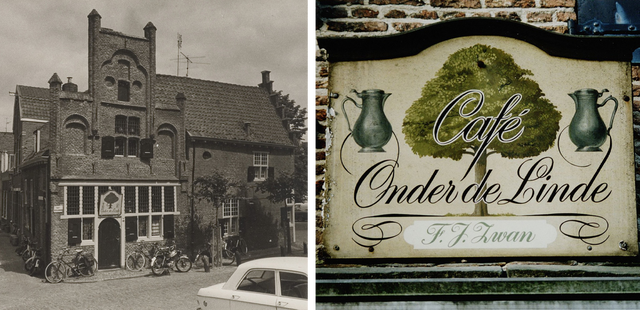On the Appel and Groenmarkt you will find a lot of historic buildings, several of which are listed as national monuments. But not all of the archaeological riches are visible. Some of it turned out to be hidden under bricks and a thin layer of sand.
The mandate house

Foto links door Cor van der Braber uit 1970, foto rechts door Johan Evers uit 1996 (via Archief Eemland)
We begin at The Mandate House. You will find this at the point of Groenmarkt, Papenhofstede and Appelmarkt. As early as 1755 it was called Onder de lindeboom and today it is called Onder de Linden. But, you may wonder, what is a Mandaatshuisje anyway?
In 1317, the area around the Groenmarkt and Appelmarkt was added to the parish estates of the Sint-Joriskerk. And therefore, from then on, the same immunity applied as in the church. In other words, here you were free from persecution as a scoundrel. The urban jurisdiction had nothing to say there, or in other words they had no mandate here. By the way, you were also exempt from municipal taxes there. In 1520 it was destroyed by a big fire. The mandate house was one of the buildings rebuilt after that. Later it became a café, which it still is today.
Warehouse Building
 Foto uit 1974 door H. van Mourik (archief Eemland)
Foto uit 1974 door H. van Mourik (archief Eemland)
The building where restaurant Dikke Dirck sits today used to be the weigh house. It was probably built in 1867, after a fire destroyed the old weigh house (also). It has had various government functions over the years. In 1891, part of it was even converted into a prison. But originally goods were weighed here against payment and with government guarantee. In Museum Flehite you can see a drawing of this weighing building.
St. George's Church
 St. George's Church is the eye-catcher of squares De Hof, Appelmarkt and Groenmarkt. In the 12th century a bishop's court was founded here. This court included a chapel, which was probably dedicated to "St. George. In 1248, the chapel was replaced by a Romanesque hall church, which was later rebuilt into a Gothic cruciform church. From the early 15th century to 1534, the church was expanded into a three-aisled hall church, enclosing the 1190 tower. The once-painted medieval paintings were restored 40 years ago. And again in 2010-2011, the Sint-Joriskerk was restored. This time because the historic oak roof structures were infested by the Pied Piper.
St. George's Church is the eye-catcher of squares De Hof, Appelmarkt and Groenmarkt. In the 12th century a bishop's court was founded here. This court included a chapel, which was probably dedicated to "St. George. In 1248, the chapel was replaced by a Romanesque hall church, which was later rebuilt into a Gothic cruciform church. From the early 15th century to 1534, the church was expanded into a three-aisled hall church, enclosing the 1190 tower. The once-painted medieval paintings were restored 40 years ago. And again in 2010-2011, the Sint-Joriskerk was restored. This time because the historic oak roof structures were infested by the Pied Piper.
Hidden history
When the trees on Groenmarkt were replaced in 1997, an archaeological survey was also conducted. For, as was already known, this was once the site of the Saint George Cemetery. And indeed, not even 20 cm under the pavement, graves were found. And when even later underground garbage containers were placed, another archaeological survey was done. Which included 13th-century finds such as a beer mug, wine goblet and lance tip. Because of the rich history in these squares, which is thus both visible and invisible, a monument was placed in April 2011 to commemorate all that hidden history.
Guild Amersfoort
Want to know a lot more about the history of Amersfoort? At Groenmarkt 19 you will find Gilde Amersfoort. The more than 60 city guides of this guild know a lot about our Amersfoort history. They take you back in time during city walks, tower climbs, bicycle tours and arrangements in cooperation with the local hospitality industry.
The Appelmarkt and Groenmarkt are known for their burgundian disposition. Want to know where to taste the tastiest beer, listen to live music, show off your cool moves, feast on delicious food or join a pub quiz? You'll discover it here.
Bron: Archief Eemland
